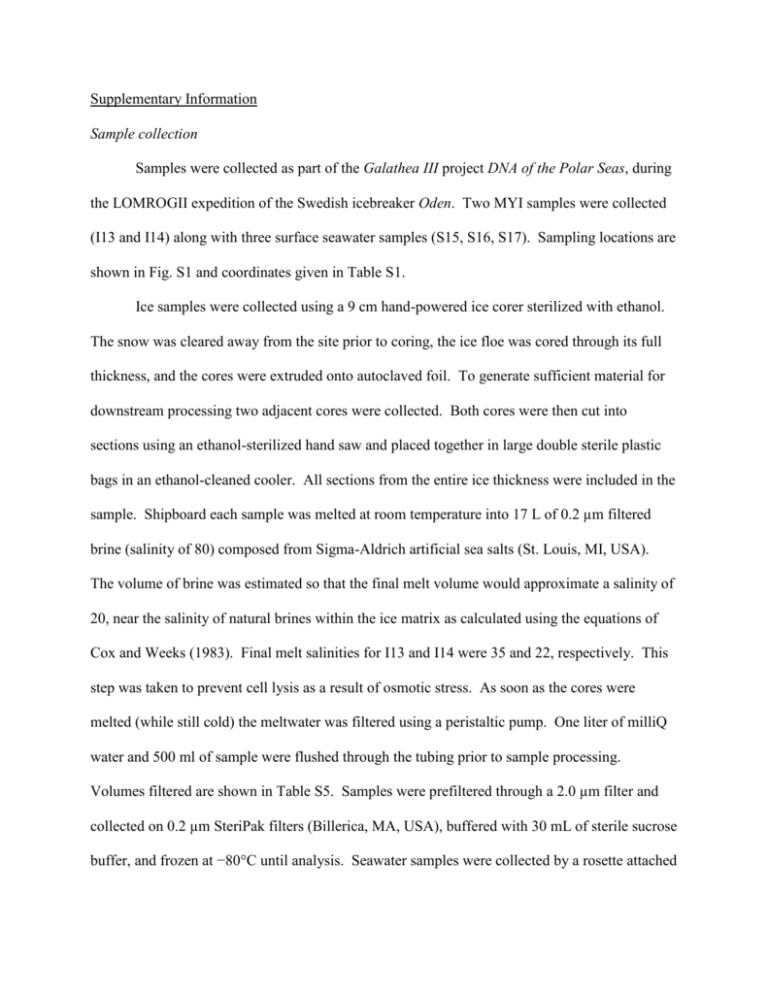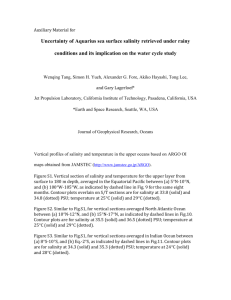Supplementary Information (doc 34K)
advertisement

Supplementary Information Sample collection Samples were collected as part of the Galathea III project DNA of the Polar Seas, during the LOMROGII expedition of the Swedish icebreaker Oden. Two MYI samples were collected (I13 and I14) along with three surface seawater samples (S15, S16, S17). Sampling locations are shown in Fig. S1 and coordinates given in Table S1. Ice samples were collected using a 9 cm hand-powered ice corer sterilized with ethanol. The snow was cleared away from the site prior to coring, the ice floe was cored through its full thickness, and the cores were extruded onto autoclaved foil. To generate sufficient material for downstream processing two adjacent cores were collected. Both cores were then cut into sections using an ethanol-sterilized hand saw and placed together in large double sterile plastic bags in an ethanol-cleaned cooler. All sections from the entire ice thickness were included in the sample. Shipboard each sample was melted at room temperature into 17 L of 0.2 µm filtered brine (salinity of 80) composed from Sigma-Aldrich artificial sea salts (St. Louis, MI, USA). The volume of brine was estimated so that the final melt volume would approximate a salinity of 20, near the salinity of natural brines within the ice matrix as calculated using the equations of Cox and Weeks (1983). Final melt salinities for I13 and I14 were 35 and 22, respectively. This step was taken to prevent cell lysis as a result of osmotic stress. As soon as the cores were melted (while still cold) the meltwater was filtered using a peristaltic pump. One liter of milliQ water and 500 ml of sample were flushed through the tubing prior to sample processing. Volumes filtered are shown in Table S5. Samples were prefiltered through a 2.0 µm filter and collected on 0.2 µm SteriPak filters (Billerica, MA, USA), buffered with 30 mL of sterile sucrose buffer, and frozen at −80°C until analysis. Seawater samples were collected by a rosette attached to the CTD. Seawater was transferred aseptically to sterile polycarbonate bottles and filtered immediately using a procedure identical to that described for sea ice. Volumes filtered are shown in Table S5. Environmental parameters Parallel cores were taken to determine temperature, chlorophyll a, cell count, salinity, and pEPS (Fig. S5). These cores were sectioned on site into 20-cm sections and placed within sterile Whirlpak bags (Ft. Atkinson, WI, USA). Shipboard the cores were melted into an equal volume of 0.2 µm filtered brine. Salinity was calculated from the concentrations of salt required to produce the final salinity observed with a refractometer from a known volume of melt solution combining with a known volume of ice melt. Aliquots for the analysis of chlorophyll a were filtered onto Whatman GFF filters (0.7 µm retention) and stored in dark tubes at −20°C until analysis by fluorescence (Arar and Collins, 1997). Aliquots for cell counts were fixed with 37 % formaldehyde to a final concentration of 2 % and stored at 0°C until staining with the DNA specific stain 4',6-diamidino-2-phenylindole (DAPI) and analysis by epifluorescence microscopy. Fractions for the analysis of pEPS were filtered onto 0.4 µm polycarbonate filters and frozen at −20°C until analysis by the phenol-sulfuric assay as described previously (Marx et al., 2009). DNA extraction, purification, and sequencing DNA extraction, purification, and sequencing were performed at the University of Copenhagen, Denmark. Cells were lysed directly on filter and the DNA extracted with phenolchloroform. One nanogram of DNA was amplified using the universal prokaryotic primers PRK341F (CCTAYGGGRBGCAACAG) and PRK806R (GGACTACNNGGGTATCTAAT) (Yu et al., 2005). PCR product was reamplified using the same primers with different 5’ tags. Product from the second PCR was purified by gel electrophoresis. Tagged PCR products were pooled together (5 x 105 DNA copies sample–1) and sequenced on a GS FLX pyrosequencer (454 Life Sciences, Branford, CT, USA). Sequencing in this manner produced an average read length of 221 bp. Sample coverage is illustrated by rarefaction curves for various definitions of OTU (Fig. S6). Performance of the PRK341F and PRK806R primers was analyzed using the OligoCheck program. The primer set was determined to have good performance at the domain level for both Bacteria and Archaea (78.7 % and 67.7 % efficiency); however, the primer set does not perform well for specific clades in both domains (Fig. S4). Within Bacteria, Planctomycetes and Cyanobacteria have low binding efficiency with the primer set. Within Archaea, the Crenarchaeota, particularly marine Crenarchaeota, have poor binding efficiency. Supplementary references Arar EJ, Collins GB. (1997). National Exposure Research Laboratory, Office of Research and Development. Ashelford, KE (2010). OligoCheck 1.0. Cox GFN, Weeks WF (1983). Equations for determining the gas and brine volumes in sea-ice samples. Journal of Glaciology 29: 306−316. Marx JG, Carpenter SD, Deming JW (2009). Production of cryoprotectant extracellular polysaccharide substances (EPS) by the marine psychrophilic bacterium Colwellia psychrerythraea strain 34H under extreme conditions. Can. J. Microbiol. 55: 63−72. Yu Y, Lee C, Kim J, Hwang S (2005). Group-specific primer and probe sets to detect methanogenic communities using quantitative real-time polymerase chain reaction. Biotechnology and Bioengineering 89: Tiles and Legends to Supplementary Figures Fig. S1. Sampling locations in the Arctic Ocean. Two MYI samples (I13 and I1) and three surface seawater samples (S15, S16, S17) were collected. Fig. S2. Correlation between Simpson’s index of diversity and the non-parametric implementation of Shannon’s index. Good agreement was observed for all samples at all definitions of OTU (r = 0.94, df = 18, p < 10–4). Fig. S3. Fraction of reads unclassified at taxonomic level. The percentage of reads unclassified at each taxonomic level was determined using Mothur’s classification tool and a custom database of 14 956 high quality bacterial and 2 297 high quality archaeal sequences. Fig. S4. Primer set exclusions. In silico analysis of the primer set suggested good coverage of the domains Bacteria, though specific clades were likely underreported in the dataset as a result of exclusion by the primer set. In the domain Archaea, Crenarchaeota are likely highly underreported as a result of primer set exclusion. Fig. S5. Ice core profiles. Temperature and salinity profiles for I13 and I14 are shown. Fig. S6. Rarefaction curves. Rarefaction curves at 100, 97, 90, and 80 % similarity for MYI (I13 and I14) and seawater (S15, S16, S17) communities were created using Mothur.







